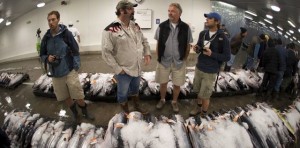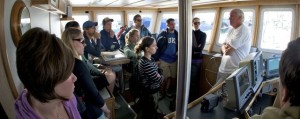6:00 AM Honolulu Fish Auction
Meet Sean Martin – fisherman, owner/operator of 6 pacific longliner boats, supplier of bait, tackle and safety equipment to the 130 boat longline fleet, former chairman of WESPAC (www.wpcouncil.org) and CEO of POP Hawai (www.pop-hawaii.com), a major equipment supplier to the fleet. He is giving us a tour of the fish auction today.

Some of the class are wearing flip flops – a no-no inside the auction so Sean walks to his office and gets everybody rubber boots. This from the man that stands 6’ 5”, is wearing a white t shirt, shorts and tennis shoes… Should be interesting.




The fish auction sells the fish caught by a limited entry fleet of 130 boats that fishes the Pacific both inside the US EEZ and beyond on the high seas. These guys go where the fish are; sometimes traveling 1000 miles from Honolulu in search of big eye tuna and swordfish. The Hawain Longline Association (www.hawaiilongline.org) represents the entire fleet. Sea Martin is president of HLA.

Today there is around 80,000 lbs of fish being sold. 30,000 lbs is swordfish and there is no market in the Pacific for this fish – no one wants to eat it. It is all being sold in lots, loaded into containers and shipped to the eastern U.S. The rest of the fish is mainly tuna – big eye, yellowfin, albacore and some skipjack. There is some fish in the auction that would be considered bycatch elsewhere – marlin, spearfish, moonfish, mahi mahi and a shark. Everything is sold fish by fish in the auction – fast, efficient, a well oiled machine. Most of the fish is sold to local restaurants here on the island. With 8 million tourists coming every year, the demand for fresh fish is always there. The auction starts at 6 am and is over by 7 am. The 50,000 lbs of tuna is sold fish by fish, labeled, packed in ice and loaded on trucks and disappears. The auction runs 6 days a week all through the year.

Sean takes us on a tour of one of his boats that are in port for maintenance. We climb aboard the Caroleigh, a custom side-setter built by Martin in response to federal regulations to reduce albatross by-catch. He takes us to the bridge and holds court answering questions from the class for 30 minutes. The Hawaian longline fleet is the most litigated and most regulated fishing fleet in America. He explains turtle “take” reduction, describes a typical fishing trip that lasts 14-20 days. He shows is the VMS – vessel monitoring system – that enables NOAA and the Coast Guard to track the entire US fleet anywhere in the Pacific. The only other working VMS tracking system outside of the feds is in Sean Martin’s office. Sean explains that longliners catch only a fraction of the tuna in the Pacific with the purse seiners doing the real damage. He talks about competition from foreign fleets, saying that the US longline fleet is outnumbered 19:1 on the high seas. That Costco across the street from the auction is selling imported Chinese tuna not US-caught and that the foreign factory ships that catch, clean and freeze are doing the real damage. The Hawaian longline fleet are just hard working Americans making a living and providing fresh fish. Sean says that NOAA and the environmental groups keep hammering on him to alter his fishing techniques, fish less days at sea, reduce bycatch. He says that much progress has been made in reducing bycatch. He makes a compelling case.

The Pacific longline total catch is worth about $60M a year, according to Sean. That is mouse nuts compared the rest of the international Pacific tuna fleet. Sean Marin is a successful robber-baron here in the Pacific. A man like Rockefeller with oil, Stanford with railroads and Gates with software, who arrived in Hawaii on a longliner from California in 1979 and built an empire brick by brick, fought off his environmental foes and NOAA, made changes in the fleet’s fishing practices and is still in business making money. I like how Sean operates. He gets things done, creates jobs, provides a good product. He gives the same tour to school kids. The entire longline fishing business with all the bycatch, regulations and restrictions sucks big time. And each of us could choose to stop eating fish and solve the overfishing problem. But in the meantime you gotta like this man.
10:00 AM NOAA Pacific Islands Regional Office
We next traveled to downtown Honolulu to the NOAA PIRA office and met first with Lisa Van Atta who holds the title of Assistant Regional Administrator – Protected Resources. What does she do? Well if an endangered Hawaiian monk seal hauls out on the Waikiki Beach at noon during the peak tourist season and some dad pops his 5 year old on the seal’s head for a photo, you call Lisa. She is a lawyer. She fixes things. And she has a tough job balancing the management of endangered species like the monk seal and the interactions with 8 million tourists here. As a species, monk seals are in a steep population decline – around 1,000 left with a 4% population lost each year. Somebody shot three seals in the last year in the Main Hawaiian Islands (MHI). On top of that she has to watch out for the whales, spinner dolphin and turtles. Like I said she is a lawyer, they fix things.
Lisa talks with confidence and ease about the challenges of her job. She has a great staff including several Duke Nicholas School grads, but is being buried under a mounting paperwork covering not only these megafauna, but now corals that are endangered by climate change. Public outreach, take reduction teams, lawsuits, policy, rules, regulations, restrictions… a tough business in this day and age. She is good, but she needs more help.
1:30 PM NOAA Pacific Islands Regional Office
Our final meeting of the day is with Dr. Charles Litnan who leads the Hawaiian Monk Seal Survival Enhancement Program. Charles is an experienced scientist leading the charge to save the monk seal from extinction. The issue is so complicated and has so many ethical ramifications, I can not even begin to tell this story without more coffee. All the parts of a great story are here – an ancient marine mammal lineage that has gone extinct in the Caribbean, hanging on in the Mediterranean, but dying out in Hawaii; elected officials who say do what ever to protect the seal, but do not let it die off on my watch, decades of field work in the Northwestern Hawaiian Islands (NWHI) where the seal was almost counted to death year after year. And now Charles is supposed to step in and save the species. The man is smart, hard working and knowledgeable on all aspects of the monk seal, yet he must consider any measure to protect the species – even killing Galapagos sharks that prey on monk seal pups. The thought of intervening in a natural ecosystem to protect the monk seal by killing the sharks did not go over so well with with the class. Like I said it is complicated… I hope other members of the class will blog on this issue. Asking a NOAA scientist to decide which creature lives and which one dies is above my pay grade.
For more information check out these links:
http://www.eturbonews.com/7373/hawaii-foia-lawsuit-will-be-early-test-new-obama-transparency-pol

So great to see all of you where we were last year. Wish I was still there! Brings back some amazing memories. Hope you’re all enjoying it…it’s an incredible experience.
It’s sad to hear about the monk seal plight and the issue with the sharks. I agree that it’s a really tough issue. Last year they were also considering culling sharks to protect the seal, and that didn’t go over so well with our class either. I’ve learned a bit more about it over the past few months working at the Marine Conservation Biology Institute (which works to support protection of the monk seal), and I still think it’s hard to figure out how best to resolve the issue. I agree with you Tom- I’m kind of glad I’m not the one making the decision as to which creature lives or dies!
Thanks for the updates. It’s great to relive the experience through all of your eyes! 🙂 Wendy
Wendy,
it is a real struggle both for the seals and NOAA. I am not sure who is in worse shape – the NOAA people trying to fix nature or the seals trying to cope with change in their environment. But a great group of students – last year’s group was superior in all ways of course….
peace
Tom